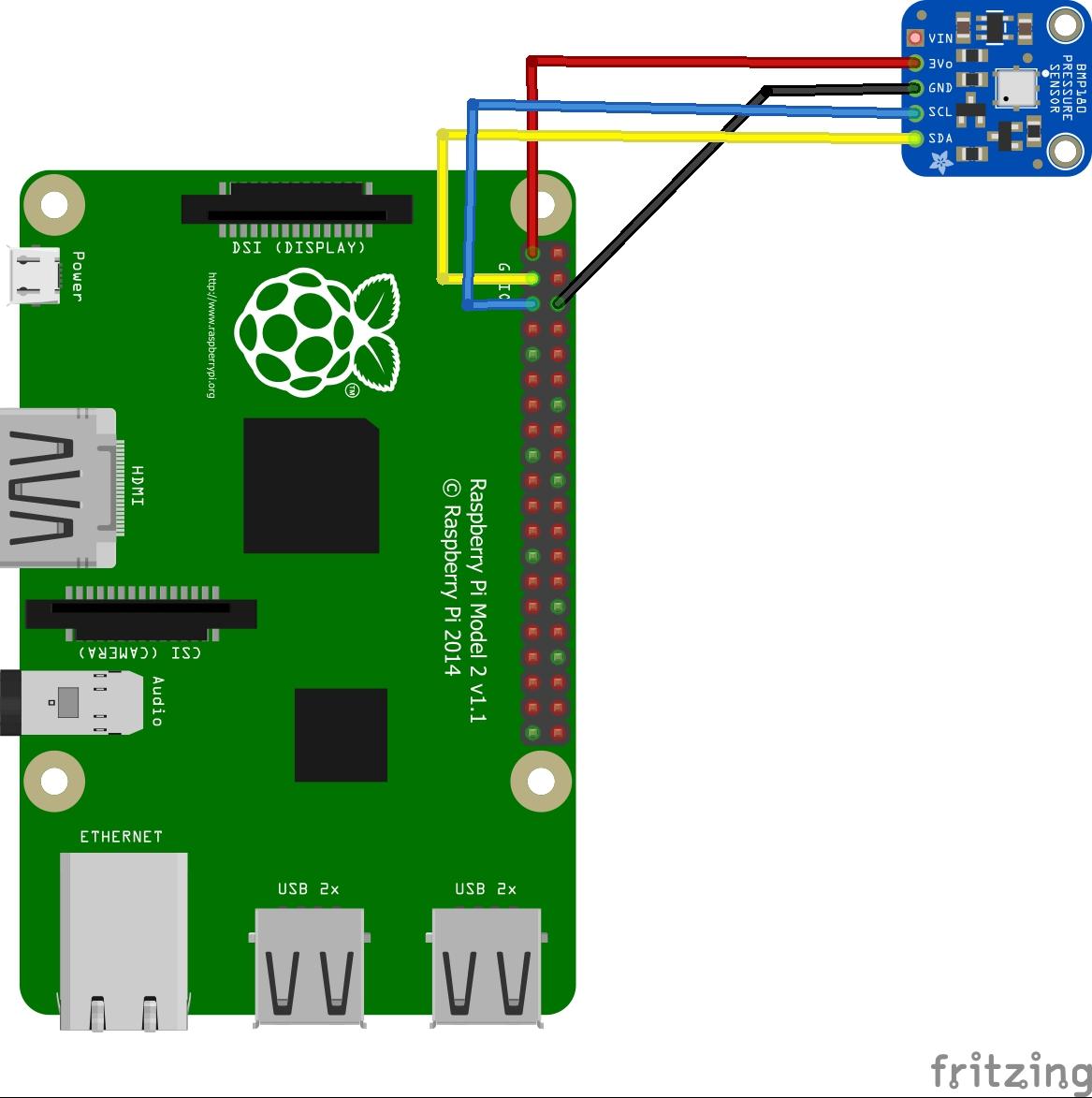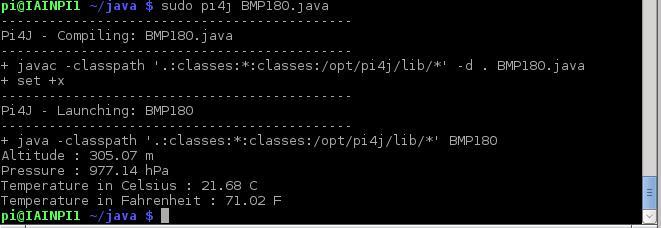In this example we will connect an BMP180 digital temperature sensor to a Raspberry Pi and use Java to display the temperature readings, there are other languages such as C and python which work as well but I wanted to try something a little different
Here is a recap of the sensor
The BMP180 is the new digital barometric pressure sensor of Bosch Sensortec, with a very high performance, which enables applications in advanced mobile devices, such as smartphones, tablet PCs and sports devices. It follows the BMP085 and brings many improvements, like the smaller size and the expansion of digital interfaces.
The ultra-low power consumption down to 3 μA makes the BMP180 the leader in power saving for your mobile devices. BMP180 is also distinguished by its very stable behavior (performance) with regard to the independency of the supply voltage.
You can read more – https://www.bosch-sensortec.com/bst/products/all_products/bmp180
Parts List
| Label | Part Type | |
|---|---|---|
| Part2 | Adafruit BMP180 | |
| Raspberry Pi1 | Raspberry Pi 2 |
Layout
Code
This time we explore the world of Java on the Raspberry Pi
First you need to install PI4j – http://pi4j.com/install.html . I’ll sum it up as its easy to install from a terminal
The simplest method to install Pi4J on your RaspberryPi is to execute the following command directly on your RaspberryPi.
curl -s get.pi4j.com | sudo bash
Now for the java code – this is courtesy of a controleverything example
[codesyntax lang=”java”]
// Distributed with a free-will license.
// Use it any way you want, profit or free, provided it fits in the licenses of its associated works.
// BMP180
// This code is designed to work with the BMP180_I2CS I2C Mini Module available from ControlEverything.com.
// https://www.controleverything.com/content/Pressure?sku=BMP180_I2CS#tabs-0-product_tabset-2
import com.pi4j.io.i2c.I2CBus;
import com.pi4j.io.i2c.I2CDevice;
import com.pi4j.io.i2c.I2CFactory;
import java.io.IOException;
import java.lang.Math;
public class BMP180
{
public static void main(String args[]) throws Exception
{
// Create I2C bus
I2CBus bus = I2CFactory.getInstance(I2CBus.BUS_1);
// Get I2C device, BMP180 I2C address is 0x77(119)
I2CDevice device = bus.getDevice(0x77);
// Calibration Cofficients stored in EEPROM of the device
// Read 22 bytes of data from address 0xAA(170)
byte[] data = new byte[22];
device.read(0xAA, data, 0, 22);
// Convert the data
int AC1 = data[0] * 256 + data[1];
int AC2 = data[2] * 256 + data[3];
int AC3 = data[4] * 256 + data[5];
int AC4 = ((data[6] & 0xFF) * 256) + (data[7] & 0xFF);
int AC5 = ((data[8] & 0xFF) * 256) + (data[9] & 0xFF);
int AC6 = ((data[10] & 0xFF) * 256) + (data[11] & 0xFF);
int B1 = data[12] * 256 + data[13];
int B2 = data[14] * 256 + data[15];
int MB = data[16] * 256 + data[17];
int MC = data[18] * 256 + data[19];
int MD = data[20] * 256 + data[21];
Thread.sleep(500);
// Select measurement control register
// Enable temperature measurement
device.write(0xF4, (byte)0x2E);
Thread.sleep(100);
// Read 2 bytes of data from address 0xF6(246)
// temp msb, temp lsb
device.read(0xF6, data, 0, 2);
// Convert the data
int temp = ((data[0] & 0xFF) * 256 + (data[1] & 0xFF));
// Select measurement control register
// Enable pressure measurement, OSS = 1
device.write(0xF4, (byte)0x74);
Thread.sleep(100);
// Read 3 bytes of data from address 0xF6(246)
// pres msb1, pres msb, pres lsb
device.read(0xF6, data, 0, 3);
// Convert the data
double pres = (((data[0] & 0xFF) * 65536) + ((data[1] & 0xFF) * 256) + (data[2] & 0xFF)) / 128;
// Callibration for Temperature
double X1 = (temp - AC6) * AC5 / 32768.0;
double X2 = (MC * 2048.0) / (X1 + MD);
double B5 = X1 + X2;
double cTemp = ((B5 + 8.0) / 16.0) / 10.0;
double fTemp = cTemp * 1.8 + 32;
// Calibration for Pressure
double B6 = B5 - 4000;
X1 = (B2 * (B6 * B6 / 4096.0)) / 2048.0;
X2 = AC2 * B6 / 2048.0;
double X3 = X1 + X2;
double B3 = (((AC1 * 4 + X3) * 2) + 2) / 4.0;
X1 = AC3 * B6 / 8192.0;
X2 = (B1 * (B6 * B6 / 2048.0)) / 65536.0;
X3 = ((X1 + X2) + 2) / 4.0;
double B4 = AC4 * (X3 + 32768) / 32768.0;
double B7 = ((pres - B3) * (25000.0));
double pressure = 0.0;
if(B7 < 2147483648L)
{
pressure = (B7 * 2) / B4;
}
else
{
pressure = (B7 / B4) * 2;
}
X1 = (pressure / 256.0) * (pressure / 256.0);
X1 = (X1 * 3038.0) / 65536.0;
X2 = ((-7357) * pressure) / 65536.0;
pressure = (pressure + (X1 + X2 + 3791) / 16.0) / 100;
// Calculate Altitude
double altitude = 44330 * (1 - Math.pow((pressure / 1013.25), 0.1903));
// Output data to screen
System.out.printf("Altitude : %.2f m %n", altitude);
System.out.printf("Pressure : %.2f hPa %n", pressure);
System.out.printf("Temperature in Celsius : %.2f C %n", cTemp);
System.out.printf("Temperature in Fahrenheit : %.2f F %n", fTemp);
}
}
[/codesyntax]
Now you have to compile and run the program like this
$> sudo pi4j BMP180.java
Testing
You should see the following
Links
1PCS GY-68 BMP180 Replace BMP085 Digital Barometric Pressure Sensor Module For Arduino



